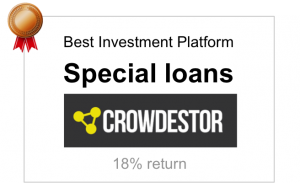The privately assigned loans became known and popular through the Internet. The provider of peer-to-peer loans is, among others, the British company, which was the first online platform in 2005 with a platform worldwide. You can now grab on to the Crowdestor review.
The principle: borrowers borrow money on individual terms (which the lender sets) and pay a fee of around one percent of the borrowed amount. Even with peer-to-peer loans will be like a bank loan, a corresponding credit rating is required.
The risk of loan default is reduced in part online, as the corresponding provider distributes the sum to several borrowers and limits the loan accordingly per borrower. Lending is usually free of charge for peer-to-peer loans.
Peer-to-peer, also referred to as P2P loans or crowd-lending, translates into “human-to-human” or “from a private person to private individual” in English. A peer-to-peer loan is, therefore, a type of loan that is settled between two private individuals.

Another common name is the C2C credit, the consumer-to-consumer credit between consumers. This type of lending is still quite young and has only been established in the financial market for almost ten years. Companies like Crowdestor finance themselves with low fees, which are calculated from a few percents of the loan amount.
There is no intermediary bank for a peer-to-peer loan. Instead, Crowdestor acts as an active platform for European investors and borrowers from Estonia, Finland, and Spain. Significant advantages result for both sides:
The bureaucratic effort and high fees of the banks fall away. Investors can build a broad portfolio through Crowdestor, keeping an eye on their risk whenever they want to invest money safely. Crowdestor’s modern investment tools help to better assess borrowers. Investors benefit from higher returns compared to other asset classes.
What is the difference between crowdfunding and crowd investing?
Crowdlending (P2P credit) is a subset of crowdfunding. While funding includes all options for collecting funds on an online platform, Crowdlending specifically refers to lending from private to private. Likewise, crowdfunding does not require financial interests.
To distinguish the term is also to crowd investing. Here, the power of flock financing is used to make a certain investment. This can be, for example, a property. There is a clear financial interest behind the investment.
How do P2P loans work?
To grant a P2P loan and thus obtain attractive interest rates, the person who is interested in it must first register on a platform such as Crowdestor.
a After registration, which takes only a few moments, the lender or investor can view a list of investment opportunities. In addition to the project to be financed here is also a classification into one of the different risk classes. The return that can be achieved with a P2P loan depends on the risk class. As with other investments, there are risky assets or investments, usually with higher return prospects.
Advantage and disadvantages of crowdlending at a glance
Like all investments, crowd lending has pros and cons.
Return Opportunities: P2P loans offer high return opportunities for investors. It divides investments into different risk classes so that the investor can weigh the return and risk. At Crowdestor, the private investor even receives special online tools that quickly give him an overview and spare the acquisition of extensive prior knowledge.
